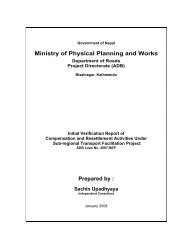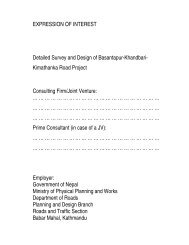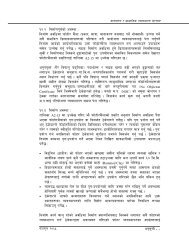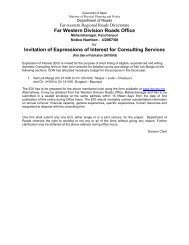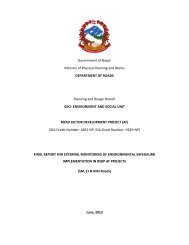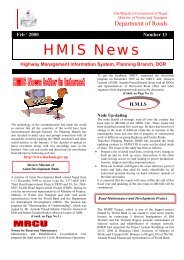Environmental & Social Management Framework - About ...
Environmental & Social Management Framework - About ...
Environmental & Social Management Framework - About ...
Create successful ePaper yourself
Turn your PDF publications into a flip-book with our unique Google optimized e-Paper software.
<strong>Environmental</strong> and <strong>Social</strong> <strong>Management</strong> <strong>Framework</strong>mitigation measures at an early stage to avoid any disastrous consequences.The same approach also applies during <strong>Environmental</strong> Audit to be carried out twoyears after completion of each road project. These monitoring activities will alsoindicate how accurate was the impact prediction, and how efficient were thecorresponding mitigation measures. The main monitoring instrument is the set ofindicators identified in the EMAP.An important verification instrument are thematic (GIS) maps, especially thosereferring to ecologically, sociologically and culturally sensitive areas, as well asmaps showing the pre-construction land-use activities and community properties.ad ii)Monitoring Activities during Construction Phase.Compliance monitoring will be done by the Project <strong>Management</strong> (in-house orappointed individual professional or professional organization), and closelymonitored by the DoR/GESU at the central level to ensure that EMAPrecommendations are complied.The main parameters for measurement will include, among others:• Verification that the EA mitigation recommendations relevant to theContractor’s are understood well by the contractors and his foremen / fieldsupervisors• health and sanitation aspects with respect to the ongoing construction works;• waste management precautions and procedures;• use, storage and handling procedures for hazardous and constructionmaterial;• social impacts and/or imbalances associated with the ongoing activities;• Gender issues observed;• employment pattern and schedules;• restriction of children’s work.The impact monitoring during this project phase focuses on pre-identified (in theEMP) indicators to assess whether the impacts have been accurately predicted,and whether the mitigation measures are sufficient and effective. Effectparameters would include, among others:• quality and quantities (at different seasons) of water resources at criticaladjacent areas like crossing of major water bodies;• quality and quantities (at different seasons) of potable water supply to workcamps and affected villages;• disposal areas and hazardous waste dump areas for leaching or run-off;• natural and/or artificial re-vegetation at erosion-prone areas;• status and disturbance of flora and fauna in areas adjacent or in the reach ofinfluence of the construction activities;• status of forests and forest species diversity, including community forests;• status and/or maintenance requirement for re-vegetation and slopestabilization;• effects of project-related employment and resettlement on both environmentaland human resources the local (or host) communities depend on.• public safety and security aspects with respect to the construction works underway;• public health;• community conflicts and social imbalances.Chapter 2-28 April 2007



![j:6 ]zg cfof ]hgf](https://img.yumpu.com/51286794/1/190x245/j6-zg-cfof-hgf.jpg?quality=85)

![x'nfsL /fhdfu { cfof ]hgf](https://img.yumpu.com/50581959/1/190x245/xnfsl-fhdfu-cfof-hgf.jpg?quality=85)
